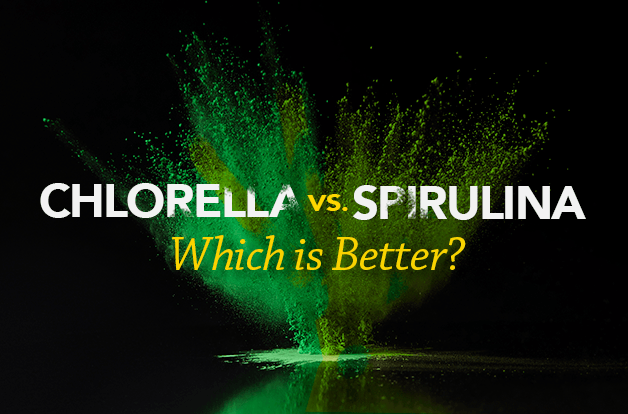Of all the colorful natural supplement powders and pills out there, two of the most memorable ones are spirulina and chlorella. If you haven't heard of either, fear not. This article will define them, compare them, and help you understand why both can improve your wellness - although I prefer one over the other, but more on that later…
Both chlorella and spirulina have a deep green hue (spirulina has a bright blue offering, as well). Both have their share of love and recent attention as more and more people learn about their unique and powerful health benefits.
What Is Chlorella? What Is Spirulina?
Chlorella and spirulina are types of single-celled microalgae. They’re in the same family as seaweed, but — as the “micro” classification suggests — they are smaller. Like many colorful plant foods, these microalgae can thank their phytochemical content for their gorgeous color, but it doesn't end there when it comes to their similarities.
Both chlorella and spirulina have a surprisingly high source of vegetarian protein, about 4 grams of protein per tablespoon. This protein is complete, meaning it contains all nine essential amino acids — which is hard to find in vegetarian food.
If you’re a workout enthusiast, that last paragraph probably caught your attention, and it should. Vegetarian protein AND complete with essential amino acids? A win-win.
Even beyond protein and aminos, chlorella and spirulina are excellent sources of several other essential nutrients, including vitamins B1, B2, folate, and the mineral magnesium—a win-win-win.
How do Spirulina and Chlorella measure up against each other?
Here’s how they measure up:
| Nutrient | Chlorella (1 tbsp/7 grams) DV* | Spirulina (1 tbsp/7 grams) DV* |
| Protein | 8.2% | 8.1% |
| Vitamin A | 118.7% | 1.3% |
| Vitamin B1 (Thiamine) | 10.4% | 14.6% |
| Vitamin B2 (Riboflavin) | 23.1% | 19.2% |
| Vitamin B6 | 5.9% | 1.5% |
| Folate | 1.6% | 1.6% |
| Magnesium | 5.3% | 3.4% |
| Iron | 50.6% | 11.1% |
| Zinc | 45.2% | 1.4% |
| Copper | 0% | 47.2% |
*Percent Daily Values (DV) are based on the FDA’s updated 2020 Nutrition Facts Label for a 2,000 calorie diet. Your needs may be higher or lower depending on your calorie needs.
While both are nutrient-dense, you’ll notice that chlorella has much higher levels of iron, Vitamin A, and zinc. If deficient in one of these nutrients, you may want to take chlorella instead of spirulina.
One other note: chlorella is rich in Vitamin K1, which can affect blood clotting, so talk to your doctor before trying chlorella, and consider spirulina if you take blood-thinning medications.
If you are one of those rare individuals with a copper deficiency, you’ll want to incorporate spirulina into your diet, as it has a much higher level of copper than chlorella.
Just a few differences, but there are many more to sift through to help you determine which microalgae is the right supplement choice for you.
Here’s what you should know:
Chlorella vs. Spirulina: A Comprehensive Guide
Chlorella Health Benefits | Why Chlorella?

Chlorella is Higher in Healthy Omega-3s
While chlorella and spirulina have comparable (and low) amounts of fat, the type of fat they contain is significantly different. Chlorella has been shown to have much higher levels of omega-3 fatty acids — essential “good” fats that the body uses to moderate or reduce inflammation. In contrast, spirulina has higher levels of omega-6 fatty acids, typically used by the body to promote inflammation. While some inflammation is good, too much can damage healthy cells and contribute to numerous illnesses.
If you need significant omega-3 support, you’ll benefit from the omega-3s found in chlorella.

Chlorella is a Chlorophyll Powerhouse
It has been found that “Chlorella has one of the highest chlorophyll contents found in nature” and impressive detoxification capabilities, as chlorophyll molecules bind to toxins in the GI tract and hold them there, preventing them from being absorbed into your tissue. In other words, the chlorophyll in chlorella can help remove toxins rather than store them. It also has strong antioxidant properties, which help counter the cellular damage caused by free radicals.

Chlorella Contains Unique Gut-Nourishing Components
Chlorella contains Chlorella Growth Factor (CGF), a unique mix of amino acids, peptides, proteins, and vitamins. Working in harmony, the nutrient complex in CGF helps stimulate the growth of healthy cells and beneficial gut bacteria, which in turn helps balance the gut microbiome.
Chlorella also has the potential to be an excellent prebiotic, thanks to its fiber and other nutritional content. That means it can act as food for the good bacteria in your gut, contributing to gut balance. Finally, the enzymes in chlorella help break down protein to promote healthy digestion.

Chlorella May Promote Heart Health
Taking chlorella regularly promotes healthy cholesterol levels. In a randomized, placebo-controlled human study, participants with high cholesterol who took 5 grams of chlorella a day saw a reduction in their triglycerides and total cholesterol after a month compared to people who received a placebo.
Chlorella Modestly Boosts Immune Health
Chlorella may help you avoid illness or recover more quickly by boosting the activity of natural killer cells. These immune system cells help remove sick or infected cells and other threats against a healthy immune system.
What is Spirulina?

Like chlorella, spirulina - a blue-green algae - has long been considered a functional food and has been harvested for centuries. If you’ve ever toasted St. Patrick’s Day with a green beer, it may have been brewed using spirulina. As a surprisingly festive microalgae, spirulina is known for many other health benefits.

Spirulina Contains Phycocyanin, an Impressive Protein
Spirulina contains the protein phycocyanin, which researchers in China and elsewhere describe as having promising anti-tumor activity, among other benefits such as antioxidant and anti-inflammatory properties.
Scientists believe that phycocyanin may contribute to helping stop toxic cells from spreading while killing off some of the cells themselves. Perhaps most encouraging, phycocyanin appears to have few to no side effects, unlike traditional anti-tumor therapies.

Spirulina Has Higher Levels of GLA, a Healthy Omega-6
The Gamma-Linolenic Acid (GLA) contained in spirulina is an omega-6 essential fatty acid. “Essential,” meaning that the body doesn’t produce it naturally, so it must be consumed in food.
The GLA omega-6 in spirulina acts more like an omega-3 in that it has anti-inflammatory effects which have been shown to improve a host of health conditions:
- Reducing the pain and swelling of rheumatoid arthritis
- Improving allergic reactions
- Getting blood pressure under control
- Supporting menopause-related hot flashes
- Supporting bone density and bone health.

Spirulina Can Sometimes Contain Toxins
Under certain growing circumstances – such as warm, brackish water contaminated with heavy metals or bacteria — spirulina can produce high levels of toxins called microcystins that are toxic to the liver.
I don’t want to scare anyone as it’s not an enormous worry. Still, one study found that, out of 18 products the researchers analyzed, 8 contained cyanotoxins that exceeded tolerable daily intake values.
What’s my professional opinion?
Given that concern and the fact that harvesting and processing chlorella is a more straightforward process using fewer chemicals, I prefer chlorella over spirulina.
The Bottom Line On Chlorella vs. Spirulina
Though spirulina and chlorella are both nutrient-dense microalgae that share several health benefits, I recommend chlorella as the healthier choice for gut health, detoxification, and dense nutritional support.
Chlorella contains more chlorophyll and other vitamins and micronutrients, plus it offers the unique benefits of Chlorella Growth Factor — all without the potential danger of toxins that spirulina carries.
When sourcing high-quality chlorella, look for one with broken cell walls, which increases nutrient absorption. I prefer Chlorella pyrenoidosa over Chlorella vulgaris due to its higher amounts of Chlorella Growth Factor, protein, and vitamins.
With these science-backed preferences and tips in choosing the best chlorella supplement, I encourage you to check out Vital Plan’s Pure Chlorella, which has been extensively researched and sourced for maximum purity and potency.
More affordable than many other chlorella supplements out there while offering exceptional quality, purity, and potency, Vital Plan’s Pure Chlorella will help soothe and calm the lining of your gut, supporting your body’s natural detoxification, digestive health, and cellular function, promoting healthy aging.
References
1. “Seaweed, chlorella, dried.” Nutrition Data. https://nutritiondata.self.com/facts/custom/569428/2
2. “Seaweed, spirulina, dried.” Nutrition Data. https://nutritiondata.self.com/facts/vegetables-and-vegetable-products/2765/2
3. José L. Garcia et al. “Microalgae, old sustainable food and fashion nutraceuticals.” Microbial Biotechnology. 2017 Sep; 10(5): 1017–1024. https://www.ncbi.nlm.nih.gov/pmc/articles/PMC5609256/
4. K Morita, M Ogata, and T Hasegawa. Chlorophyll derived from Chlorella inhibits dioxin absorption from the gastrointestinal tract and accelerates dioxin excretion in rats. Environ Health Perspect. 2001 Mar; 109(3): 289–294. URL: https://www.ncbi.nlm.nih.gov/pmc/articles/PMC1240248/
5. Takekoshi H1, Suzuki G, Chubachi H, Nakano M. Effect of Chlorella pyrenoidosa on fecal excretion and liver accumulation of polychlorinated dibenzo-p-dioxin in mice. Chemosphere. 2005 Apr;59(2):297-304. Epub 2005 Jan 7. URL: https://pubmed.ncbi.nlm.nih.gov/15722102/
6. Jarmila Vavra Ambrozova et al. “Influence of Extractive Solvents on Lipid and Fatty Acids Content of Edible Freshwater Algal and Seaweed Products, the Green Microalga Chlorella kessleri and the Cyanobacterium Spirulina platensis.” Molecules. 2014, 19(2), 2344-2360. https://www.mdpi.com/1420-3049/19/2/2344/htm
7. “Chlorella.” Science Direct. https://www.sciencedirect.com/topics/agricultural-and-biological-sciences/chlorella
8. Tomohiro Bito et al. “Potential of Chlorella as a Dietary Supplement to Promote Human Health.” Nutrients. 2020 Aug 20;12(9):2524. https://pubmed.ncbi.nlm.nih.gov/32825362/
9. Yu Yu New Oo et al. “Extraction And Determination Of Chlorophyll Content From Microalgae.” International Journal of Advanced Research and Publications. Volume 1 Issue 5, November 2017.
http://www.ijarp.org/published-research-papers/nov2017/Extraction-And-Determination-Of-Chlorophyll-Content-From-Microalgae.pdf
10. Katerina Vankova et al. “Chlorophyll-Mediated Changes in the Redox Status of Pancreatic Ca
ncer Cells Are Associated with Its Anticancer Effects.” Oxidative Medicine and Cellular Longevity. 2018; 2018: 4069167. https://www.ncbi.nlm.nih.gov/pmc/articles/PMC6051000/
11. Jung Hyun Kwak et al. “Beneficial immunostimulatory effect of short-term Chlorella supplementation: enhancement of Natural Killer cell activity and early inflammatory response (Randomized, double-blinded, placebo-controlled trial).” Nutrition Journal. 2012; 11: 53. https://pubmed.ncbi.nlm.nih.gov/24920270/
12. “Spirulina.” Science Direct. https://www.sciencedirect.com/topics/agricultural-and-biological-sciences/spirulina
13. Lianggian Jiang et al. “Phycocyanin: A Potential Drug for Cancer Treatment.” Journal of Cancer. 2017; 8(17): 3416–3429. https://www.ncbi.nlm.nih.gov/pmc/articles/PMC5687155/
14. Rakesh Kapoor and Yung-Sheng Huang. “Gamma linolenic acid: an antiinflammatory omega-6 fatty acid.” Current Pharmaceutical Biotechnology. 2006 Dec;7(6):531-4. https://pubmed.ncbi.nlm.nih.gov/17168669/
15. “Gamma-linolenic Acid.” Mount Sinai. https://www.mountsinai.org/health-library/supplement/gamma-linolenic-acid
16. “Phyocyanin.” Science Direct. https://www.sciencedirect.com/topics/agricultural-and-biological-sciences/phycocyanin
17. Audrey Roy-Lachapelle et al. “Detection of Cyanotoxins in Algae Dietary Supplements.” Toxins. 2017 Mar; 9(3): 76. https://www.ncbi.nlm.nih.gov/pmc/articles/PMC5371831/
18. Jong Beom Jin et al. “Supplementation with Chlorella vulgaris, Chlorella protothecoides, and Schizochytrium sp. increases propionate‐producing bacteria in in vitro human gut fermentation.” Journal of the Science of Food and Agriculture. 07 February 2020. https://onlinelibrary.wiley.com/doi/abs/10.1002/jsfa.10321






